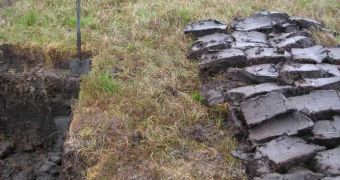As the Earth is getting warmer, climate scientists draw attention to a situation that has received very little attention over the years – that of peatlands. These soils could over the coming years turn into veritable compost bombs, capable of releasing massive amounts of carbon dioxide and methane into the atmosphere.
Peat is composed mainly of partially decayed vegetation matter, which may range in appearance and basic traits from the the tropical peat swamp to the Arctic permafrost. Regardless of form, its effect on the environment is the same.
Over millions of years, this type of soils has accumulated vast amounts of carbon dioxide from the atmosphere, and has produced large quantities of the greenhouse gas methane, which is 300 times more efficient in warming the Earth than CO2.
In the Arctic permafrost, for example, these two chemicals have been caught in a thick layer of permanently-frozen soil, hence the name. As global warming starts to make its effects felt more and more in the north, these soils are unfreezing.
As a direct result, all of the chemicals they contain get released into the atmosphere, including the large amounts of CO2 and methane that had been trapped over millions of years.
According to statistics, there is sufficient methane stored in the Arctic to tip the balance in terms of climate change beyond a point of no return. As such, preventing peatland deterioration should become a priority in combating temperature rise.
If global temperature levels rise by as little as 1.8 degrees Fahrenheit (1 degree Celsius) every 10 years from now on, the growth rate will be sufficient to destabilize certain types of peat.
The compost is generally held together by dry moss or lichen, say University of Exeter in England mathematician Sebastian Wieczorek. This vegetation could easily be removed, exposing the peat.
The really bad news is that all peatlands in the world contain an estimated 400 billion to a trillion metric tons of carbon, which is pretty much the same amount of CO2 currently in the Earth's atmosphere altogether.
In other words, we're talking about effectively doubling all carbon dioxide in circulation today, doubling its concentration in the air. This would have catastrophic consequences.
“A release of the soil carbon from peatlands into the atmosphere would therefore have an enormous impact on the climate system,” the mathematician says.
Further of concern is the fact that all of this CO2 is concentrated in just 3 percent of the world's surface.
“Some systems simply do not have dangerous levels of global warming – they are stable for any fixed value of the atmospheric temperature,” Wieczorek says in an email to LiveScience.
“However, they may have dangerous rates of global warming, meaning that they are very sensitive to how fast the atmospheric temperature increases,” he goes on to say.
“We do believe that it would be helpful for climate scientists and policymakers to think about dangerous rates of climate change, rather than just dangerous ultimate levels of global warming,” the expert concludes.

 14 DAY TRIAL //
14 DAY TRIAL //